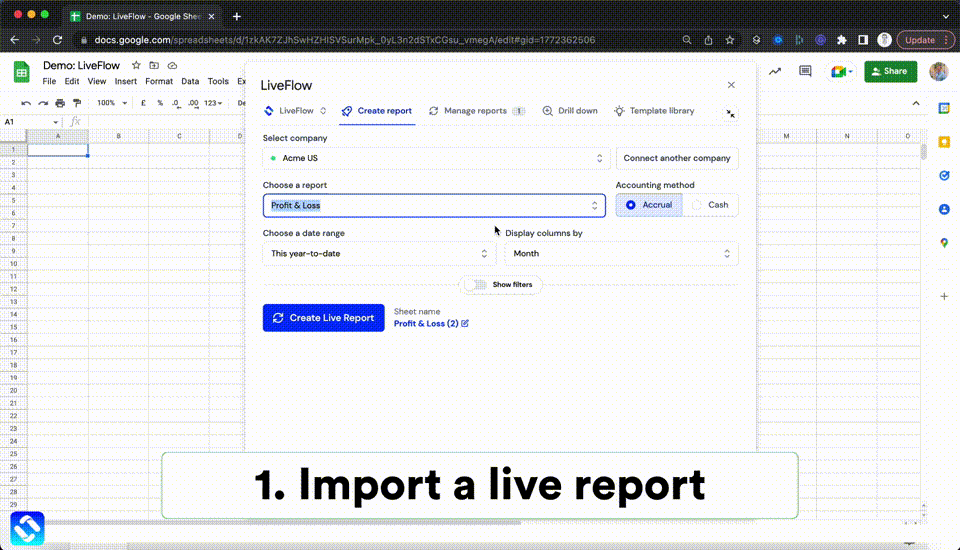Cash flow is the lifeblood of any business.
It’s an indication of how much cash your company has available at any given time. If you don’t manage your cash flow responsibly, you risk running out of money and going bankrupt, not a good scenario for any business.
Thankfully, QuickBooks has several tools built in to help you monitor and manage your cash flow so that it doesn’t threaten the long-term viability of your company.
This article explains the basics of managing your cash flow in QuickBooks. Topics covered include How to generate a QuickBooks cash flow report, how to set up a QuickBooks online cash flow forecast, and much more.
How to Report Cash Flow in QuickBooks
A cash flow forecast is a prediction of the inflow and outflow of cash for a company over a certain period of time. Cash flow forecasting is an important part of controlling a business’s finances, and a cash flow forecast template is an important tool for measuring and managing your company’s cash flow. When you know the amount of money coming in and the amount of money going out, you can make better decisions about spending, financing, and investing.
QuickBooks has several tools built-in to help you monitor and manage your cash flow. One way to report your cash flow is by using the Forecasting tool. You can access the Forecasting tool by clicking Reports at the top of your screen and choosing Forecasting. The Forecasting tool allows you to report the inflow and outflow of cash for a particular period of time, such as a month. The Forecasting tool can also help you identify trends in your cash flow.
How to Set Up Cash Flow Forecast in QuickBooks
The first thing you’ll do when setting up a cash flow forecast in QuickBooks is to create a budget. You can do this by clicking on the Planning tab, then clicking Budget. Once inside the Budget window, click the Create New Budget button and give your budget a name like “Cash Flow Budget”.
Once you’ve created a budget, the next step is to add your budget line items. To do this, click the “Add a Line Item” button and select the appropriate type of line item from the drop-down menu, such as fixed cost or revenue. Add your line items, then click Save. Now that you’ve set up your budget, you can use it to forecast your cash flow.
How to Use QuickBooks Cash Flow Forecast
The most important thing to keep in mind while using the cash flow forecast is that the numbers don’t have to be exact. What’s more important is that they are consistent and give you a clear picture of your company’s finances.
Once you’ve entered your budget numbers, you can use the cash flow forecast to project your cash flow for the next several months. To do this, simply change the dates. To forecast your cash flow for the next 12 months, for example, change the month drop-down menu to “Next 12 months.“
The cash flow forecast is useful for tracking your company’s progress throughout the year. If you notice that you’re running low on cash in a particular month, you can make adjustments to avoid future cash flow problems. This can be helpful during seasonal fluctuations when you know you’ll be bringing in less revenue. It’s also useful for tracking long-term expenses and planning for large expenditures.
What is a Cash Flow Statement in QuickBooks?
A cash flow statement is a breakdown of a company’s cash flow for a given period of time. A cash flow statement is also useful for tracking long-term expenses and planning for large expenditures, such as a new piece of equipment.
It can also help you identify where your company is spending too much money. QuickBooks allows you to create cash flow statements for the current year and previous years.
How to Create a Cash Flow Statement in QuickBooks
A cash flow statement is a breakdown of a company’s cash flow for a given period of time. As mentioned, QuickBooks allows you to create a cash flow statement for the current year and previous years. You can do this by clicking on the Planning tab and clicking Reports. Next, select Cash Flow Statement from the drop-down menu. Once inside the Cash Flow Statement window, select the appropriate period from the “Period” drop-down menu.
You can also choose to filter your report by account types, such as bank accounts or investment accounts. Once you've selected your parameters, click the "Run Report” button to generate your report. Once the report has finished running, you can click the “Open Report” button to view your report.
Summary
Cash flow is an important element for every business, and being able to keep track of your company's cash flow can mean the difference between success and failure in the long run. Fortunately, there are numerous tools in QuickBooks that make it easy to monitor and maintain your cash flow records, so that you always know exactly what’s going on with your cash flow.
You can even forecast future cash flow, which can help you prepare for any downturns ahead. All of these tools are easy to use and make it much easier to keep an eye on your small business finances.
Recommendation
QuickBooks is a great tool for financial accounting, but it can’t do everything. If you want to extend the functionality of your financial accounting suite, then you should consider adding a platform like LiveFlow. With helpful templates and features that automate many complicated accounting processes, such as the new Live Budget vs Actuals tool, LiveFlow is the perfect companion to QuickBooks.
You can even try it out for free with a 30-minute demo. So, if you want to take the stress out of accounting, then be sure to try LiveFlow today.



%20(4).png)










